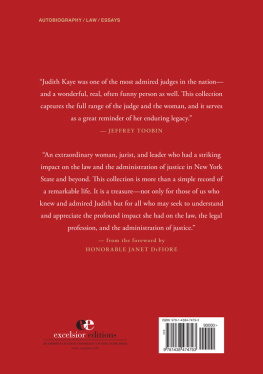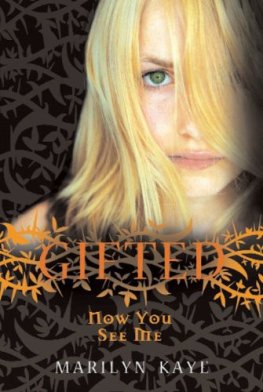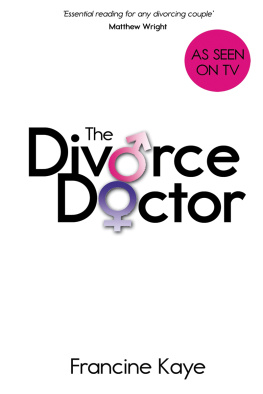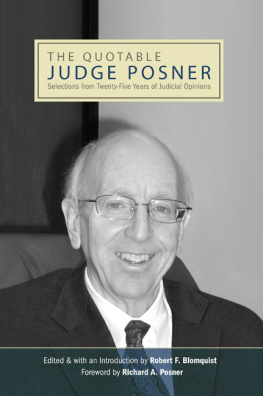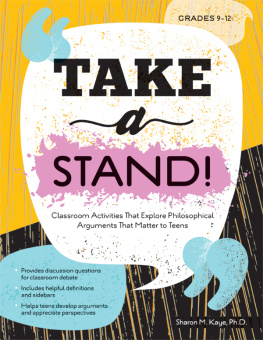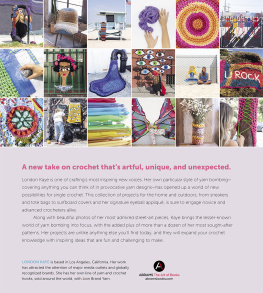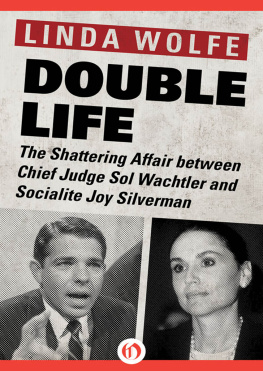JUDITH S. KAYE
IN HER OWN WORDS
JUDITH S. KAYE
IN HER OWN WORDS
REFLECTIONS ON LIFE AND THE LAW, WITH SELECTED JUDICIAL OPINIONS AND ARTICLES
Judith S. Kaye
EDITED BY
Henry M. Greenberg, Luisa M. Kaye, Marilyn Marcus, and Albert M. Rosenblatt
On the cover: Chief Judge Judith S. Kaye sits at the bench of the New York State Court of Appeals in this photo by Annie Leibovitz for the cover of a 1998 issue of Vanity Fair magazine. Courtesy of Annie Leibovitz. Cover design by Elise Brauckmann.
Published by State University of New York Press, Albany
2019 Historical Society of the New York Courts
All rights reserved
Printed in the United States of America
No part of this book may be used or reproduced in any manner whatsoever without written permission. No part of this book may be stored in a retrieval system or transmitted in any form or by any means including electronic, electrostatic, magnetic tape, mechanical, photocopying, recording, or otherwise without the prior permission in writing of the publisher.
Excelsior Editions is an imprint of State University of New York Press
For information, contact State University of New York Press, Albany, NY
www.sunypress.edu
Library of Congress Cataloging-in-Publication Data
Names: Kaye, Judith S., 19382016, author. | Greenberg, Henry M., 1961 editor. | Kaye, Luisa M., 1965 editor. | Marcus, Marilyn, editor. | Rosenblatt, Albert M., editor.
Title: Judith S. Kaye in her own words : reflections on life and the law, with selected judicial opinions and articles / edited by Henry M. Greenberg, Luisa M. Kaye, Marilyn Marcus, and Albert M. Rosenblatt.
Description: Albany : State University of New York Press, 2019. | Series: Excelsior editions | Includes bibliographical references and index.
Identifiers: LCCN 2018033290 | ISBN 9781438474793 (hardcover : alk. paper) | ISBN 9781438474816 (ebook) | ISBN 9781438474809 (pbk. : alk. paper)
Subjects: LCSH: Kaye, Judith S., 19382016. | JudgesNew York (State)Biography. | New York (State). Court of AppealsHistory. | LCGFT: Autobiographies. | Court decisions and opinions.
Classification: LCC KF373.K394 A3 2019 | DDC 347.747/035092 [B]dc23
LC record available at https://lccn.loc.gov/2018033290
10 9 8 7 6 5 4 3 2 1
T he Historical Society of the New York Courts is grateful for the substantial financial support received for this publication from the William Nelson Cromwell Foundation, of which Judge Kaye was a trustee for many years.
We are also grateful for the approval to publish and financial support of Judith Kayes three children: Luisa, Jonathan, and Gordon Kaye.
We wish to acknowledge Annie Leibovitz for graciously donating the use of her photo of Judge Kaye for the cover of this book.
CONTENTS
by Chief Judge Janet DiFiore
by Honorable Albert M. Rosenblatt
by Susan N. Herman
by Luisa M. Kaye
by Honorable Albert M. Rosenblatt
by Henry M. Greenberg
FOREWORD
C HIEF J UDGE J ANET D I F IORE
I am deeply honored that Luisa Kaye has invited me to pen a foreword to the collected memoirs, opinions, and articles of Chief Judge Judith S. Kaye, an extraordinary woman, jurist, and leader who had a striking impact on the law and the administration of justice in New York State and beyond.
Judith Kayes scholarly, eloquent, and progressive opinionsspanning a quarter century of service on the New York State Court of Appeals, one of the most influential appellate courts in the nationwill surely stand the test of time. She has influenced the course of our constitutional and common law for generations to come in momentous decisions addressing a childs right to a basic education, the death penalty, marriage and adoption rights, the scope of the rights and protections afforded by our State constitution, and on and on. Her opinions are models of judicial craftsmanship, reflecting a keen intellect; a strong command of the law; a clear, elegant writing style; and a wise understanding of human affairs.
Judiths articles reveal a prolific and sophisticated scholar with insightful and interesting perspectives on a broad range of topics. Her bold insights on judicial leadership and court reform are especially valuable, coming from a chief judge who led one of the largest and busiest court systems in the world through a period of intense social and technological change. Her vision for how the New York courts could respond more effectively to the societal problems swelling the dockets led to a problem-solving justice revolution that helped transform the delivery of justice at the national level.
Judiths memoirs and personal writings are a joy to read, illuminating a unique and fascinating woman: wise, cultivated, and elegant, of course, but also witty, fun-loving, and even a little mischievous. As she reflects on the different phases of her life, from her humble upbringing to her cherished court years, we are the beneficiaries of her sparkling intellect and a love of learning, language, and literature that shines through. In these writings, we are presented with a passionate, humane, and gracious woman who surmounted great challenges, won many victories, and suffered her share of disappointments. She loved her life, her profession, her court, and above all, her family.
This collection is more than a simple record of a remarkable life. It is a treasurenot only for those of us who knew and admired Judith but for all who may seek to understand and appreciate the profound impact she had on the law, the legal profession, and the administration of justice.
EDITORIAL PREFACE
H ONORABLE A LBERT M. R OSENBLATT
Like a symphony, Judith S. Kayes writings consist of themes, harmonies, and resolutions, encased in creative expression, imbued with beauty and passion.
As with symphonic compositions, her writings can be divided into parts, and we have chosen three: memoir, judicial opinions, and articles. It seemed sensible to begin with the memoir, followed by the opinions and articles. That is probably how Judge Kaye would have prescribed it: Here I am, Judith Kaye. Would you like to know something of my life? Read on.
Most everyone will. She was a felicitous writer: engaging, modest, and revealing without being indiscreet. Do not look for tell-all diatribes or attempts to settle scores. Judith was not like that, and it would be out of character for her to do so in her farewell account. Instead, she presents a remarkable life, including her childhood and her fidelity to her family, including her late husband, Steve; her children, Luisa, Jonathan, and Gordie; and her grandchildren.
She describes her battle with cancer, a foe she fought for several years, with some public concealment, so as not to be consigned (as she put it) to a poor Judith category. The major part of her memoir covers her years on the New York Court of Appeals, and as the states chief judge. She observes proprieties but does not shy away from describing the background and her thoughts in important cases and about policies. She is candid.
The memoir is followed by a selection of her judicial opinions. Themes and resolutions are the bread and butter of judicial opinions, and as a writer, Judiths style and elegance gave added lift to what would otherwise be little more than superb reasoning and impeccable analysis. Those who know her might read a phrase and say, Ah, yes, that sounds just like her; no one else could have written with such verve and clarity.

